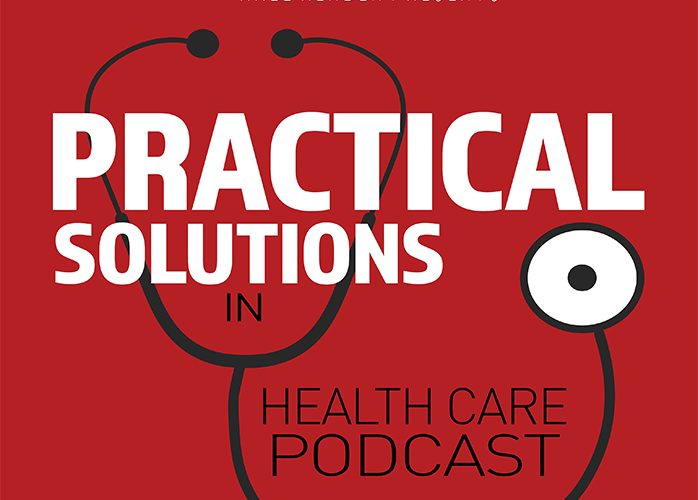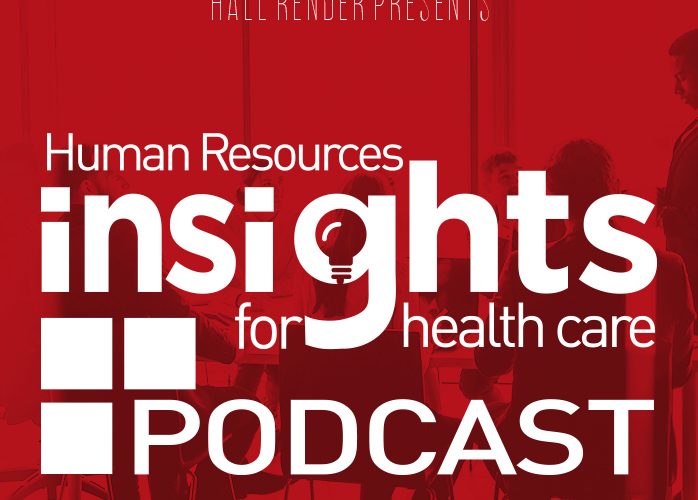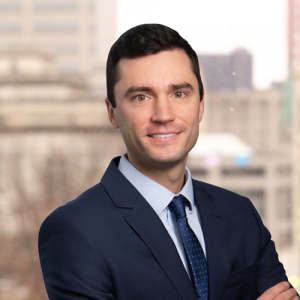Accelerated Payments and the $100 Billion Health Care Relief Fund: Financial Strategies for Providers and Suppliers
Accelerated Payments and the $100 Billion Health Care Relief Fund: Financial Strategies for Providers and Suppliers
The massive $2.2 trillion Coronavirus Aid, Relief, and Economic Security Act (“CARES Act”) signed into law March 27, 2020 includes $100 billion in reimbursement for hospitals and other health care entities to help cover COVID-19-related expenses and lost revenue.
Hall Render attorneys Liz Elias, John Williams and Lori Wink provide a 45-minute information briefing on the $100 billion health care fund, the CMS accelerated payment program and other key funding provisions included in the CARES Act. The briefing will also include recommendations about what you can do now to ensure your organization is prepared to access funding as soon as possible.
Podcast Participants

John Williams
Attorney with Hall Render

Liz Elias
Attorney with Hall Render

Lori Wink
Attorney with Hall Render
John Williams: Well, good day everyone. I hope everybody can hear me. I’m John Williams. I’m the office managing partner for Hall Render’s office in Washington D.C. I’m also the head of our Federal Advocacy service line. I want to thank everybody for joining us for this webinar on financial strategies for providers and suppliers regarding accelerated payments and the $100 billion healthcare release fund provided for in the CARES Act.
I am very pleased to be joined today by two outstanding lawyers who practice in the areas of Medicare reimbursement and regulatory matters. Liz Elias from our Indianapolis office and Lori Wink from our Milwaukee office. To give you an idea of where we’re headed today, Liz is going to walk you through the accelerated payment program. Lori is going to talk about the $100 billion in healthcare funding provided for in the CARES Act and then I’m going to discuss what might come next in a Phase 4 bill or as we discovered in the last 12 hours… 24 hours what might come as early as this week.
When we’re done, we hope you’ll know what actions you should be taking now and what steps you should take in the future and with that, I will turn it over to Lori. Lori.
Lori Wink: Thanks John. Without stating the obvious, we’re here today because expenses at health care organizations are increasing as they’re preparing for the COVID surges in treating patients. We see expenses increasing across the boards for our clients and at the same time there’s a significant disruption to non-emergent clinical services because there is cancellations and postponing of non-essential elective surgeries and procedures and clinical visits.
What we’re hearing across the country is about where… there’s a 40% decrease in these types of services being provided. One client we talked to, that was about a 200 bed hospital was losing on average about $4 million a week as a result of lost revenue and some critical access hospitals we’re talking to are seeing about a 70% decrease in this type of revenue and services because there’s no surge or cases yet in that case… cases related to COBIT in those situations but they still have the decline in revenue.
There are a number of relief funding opportunities available. In here we’ve listed 12 of the options. Today we’re going to talk about the accelerated payment program and the hundred billion in funding, but we do have full attendance that we’re releasing related to these other sources of funding and we do have additional webinars on these fundings and we’ve already had at least the first one with respect to telehealth. On the release funding strategies, what we’re recommending our clients do is they first establish a dedicated work group to really lead the funding sources and applying for the funding sources.
The next step would be reviewing these funding sources and we’re really making sure and encouraging our clients to monitor deadlines to understand the payment process with respect to these funding sources, whether it’s first come first serve under them. We need to get those applications in quicker and confirming eligibility. Then at the same time, you helped our organization’s need to track the expenses and the lost revenues related to COVID-19. There aren’t really specifics that we’re seeing on… at least in what we’re talking about today with respect to what those expenses in lost revenues are you. So you really need to create policies and procedures and just start that implementation process so you have something that’s defensible as time goes on.
Lori Wink: And then you need to submit the applications and the request as soon as possible, especially for those first come first serve and as those deadlines are approaching, then maintain the necessary documentation related to those expenses and then prepare for any reports that need to be submitted to the agencies that are releasing the funds and any subsequent audits that may occur in the future. The next slide is really just to emphasize those immediate stuff about identifying the source is in developing those policies and procedures for capturing the revenue and with that I’m going to turn it over to Liz.
Liz Elias: Thanks Lori. I’m going to talk about the accelerated payment program. Although it’s being only used a hundred times in the past five years, the CMS accelerated payment program is an existing program that allows CMS to accelerate and advance Medicare payments in order to provide emergency funding and address cashflow issues that might be caused by claims processing delays. It’s historically been used in response to natural disasters to accelerate cash flow.
However, under the CARES Act, the program has been greatly expanded. It’s essentially now a bridge loan that if it’s timely repaid can be interest free and likely won’t be viewed as debt on the balance sheet. It’s important to understand the eligibility for the accelerated payment program is not limited to hospitals. It can be accessed by other types of healthcare entities enrolled in the Medicare program as long as those providers have billed Medicare for claims within the last 180 days, they’re not in bankruptcy proceedings, they’re not under active medical review or any type of program integrity investigation, and they do not have any outstanding delinquent Medicare overpayments.
Perhaps most importantly, there is no specific need-based threshold to apply for the accelerated payment program. As far as what providers can request, most hospitals can request up to a 100% of the Medicare payment amount based on a six month look back period. However, critical access hospitals can request up to 125% of their payment amount for six months lookback period. Other types of providers and suppliers can request up to a 100% of the Medicare payment amount but only for a three month lookback period. These accelerated payment requests are submitted to the Medicare Administrative Contractors or in short the MACs.
It’s important to realize that the accelerated payment program as of this time are not in any way part of the $100 billion in the public healthcare and Social Services Emergency Fund that was also created by the CARES Act. The accelerated payment program is an entirely separate program. The applicable CMS guidance is not specific on how providers should calculate their accelerated payment amount or what types of documentation is required for that request. However, in speaking with various MACs over the past week and a half, we’ve gotten some information. CMS is providing the MACs a listing of the amount that each provider or supplier is able to obtain through this accelerated payment process, and that amount is the maximum that a provider can be approved for, the providers and suppliers can request less.
Generally speaking, these requests are going to be processed on a first in, first out basis and initially CMS stated that the MACs were going to issue payments within seven calendar days of receiving a request. However, in a briefing last evening, CMS Administrator Seema Verma stated that 17,000 accelerated payment applications have already been approved. Currently they are operating faster than the promised timeline. 25,000 applications have been received to date.
We wanted to give you an example of one of the accelerated payment request forms. This is WPS’s version of its form as of last Friday on April 3rd. Most MACs have revised their forms to simplify them and remove some of the certifications that are normally present under the regular accelerated payment program. However, we have confirmed with multiple MACs that they will accept all versions of the accelerated payment form whether it’s the CARES Act revision or the original form. Important to note on your form, when you’re completing your requests you should not include Part C or Medicare Advantage in your payment requests and we believe that the PSNR is a good source to determine what your request amount should be. There isn’t guidance out there specifically to point to a specific data source for you to use but the PSNR would be a good place to get that information.
Additionally, we’ve gotten information from the MACs encouraging us to tell providers that you would want to complete separate forms for sub units like inpatient rehab facilities and inpatient psych facilities and you’d want to send those in ideally in a separate emails so that they all have their own separate delivery timeline to the Mac. Likewise, if you bill under multiple MPIs, you would want to submit a separate request form for each NPI. Some MACs, they’re requiring these forms to be signed by an authorized official. If you’re not sure of who might be listed on your 855 as your authorized official, the person… if you complete a Medicare cost report, the person who signs your Medicare cost report is an authorized official and would be a good rule of thumb to use for signing these accelerated payment requests.
As far as the funds transmissions, these payments are coming through as regular Medicare remits. It is supposed to be the only thing that is on that remit and the remittance advice is somehow supposed to state that it’s the accelerated payment. The first payments went out overnight last Thursday on April 2nd. Anecdotally we’re hearing early reports that the initial payments are matching the requests or within the realm of reason. We do want to caution providers to watch the remittance advices carefully. We have received some information that CMS has given only three months of payment for some hospitals.
Similarly we are hearing that some critical access hospitals are not receiving the 125% payment amount. They’re receiving the 100% payment amount. These are being corrected as they’re being brought to the attention of the MACs and CMS is also working to update its list but if you do find yourself in a situation where the payment doesn’t closely match your requests, you might want to reach out to your MAC to see if you might fall into one of these outliers in the CMS data.
This is just an example just so you can see what the sort of processes and the requested amount and how they’re lined up with a payment and that this also has a critical access hospital and they’re just… you can see that as an example. As I said at the outset of my remarks, this is essentially a loan. It does have to be repaid. Currently the way the recruitment process is going to work for all providers regardless of what type of provider you are, the recruitment is going to start on day 120 after you’ve received your accelerated payments, and that recruitment is going to be against your paid claims.
Starting on day 120 you might experience a dip in your Medicare payments for some period of time while that recruitment is happening. For other providers besides hospitals, the recruitment period is going to last 90 days and on day 210 if there’s any remaining balance, providers will have 30 days to pay that outstanding balance or interest could start being assessed on day 241. There are supposed to be demand letters that are sent by the MACs, but we would recommend that providers calendar these dates so that you keep track of them internally just in case you don’t receive communication from your Mac. Just to recap, recruitment starts on day 120. Day 210 is your 30 day warning and on day 241 is when the interest could start to accrue.
Similarly for hospitals, they will also be assessed interest, but the interest for hospitals will not begin until one year after the accelerated payment is received. Likewise, you should get a demand letter from your MAC at the one year mark. The interest rate is currently set at 10.25%. The [HA 00:13:45] sent a letter earlier this week to advocate for a lower interest rate and possible loan forgiveness. However, in response to the HA’s letter from Monday, CMS Administrator Seema Verma made a statement that CMS is required to use that 10.25% interest rate because it is set by the treasury department and their hands are tied. We’ll have to watch and see if there are any further changes made to reduce that interest rate but right now CMS is saying that they don’t have the ability to adjust that interest rate.
Provide may also request an extended repayment plan if the recruitment process is not feasible for you at the 120 day timeline. There is a CMS manual process that outlines that and you should reach out to your MAC if you have any questions about the extended repayment plan, and just again to summarize for the hospitals, the deadlines would be day 120, interest day 365 would be your sort of warning and then you would have another 30 days. On day 395 is when your interest could start accruing and with that, I’m going to kick it back to Lori for some discussion on the $100 billion healthcare relief fund.
Lori Wink: The 100 billion in funding. Let me give you a roadmap as to where I’m going with this. First I’m going to start with a summary of the statute and the statute really is three pages of text in the CARES Act. There is no regulations and there’s no written guidance that we have with respect to the implementation of these laws. What we have are proposals from different associations that I’ll go through and arguably those are a little bit dated because then we’re going to go through the information that we have from CMS.
With respect to the hundred billion in funding, the CARES Act allows a hundred billion that’s available to providers until expended. That really makes it sound like it’s a first come first serve process, but we’ll wait and see how that works out and it’s for responses to the COVID-19 crisis. Is for eligible healthcare providers for healthcare related expenses and lost revenues that are attributable to the coronavirus. Now importantly in the CARES Act, eligible healthcare providers for purposes of this funding includes public entities, Medicare, Medicaid, enrolled suppliers and providers, for profit and non for profit entities that treat individuals with suspected or actual COVID-19. Now my slides aren’t working. There we go.
Importantly, this is not tied to the Medicare definition of a provider. It includes more than just hospitals and includes nursing facilities, physicians, ambulatory surgery centers, federally qualified health centers, rural health clinics, home health agencies and the list goes on. With respect to what’s eligible, again, it’s covered expenses and lost revenues. Now the CARES Act does stipulate that when they’re paying for the expenses or lost revenues, it cannot be reimbursements that are… expenses and revenues that are covered from other sources or other sources are obligated to pay for those.
The act also may include broad funding definitions. It includes alternative care sites, supplies including PPE, operational issues, surge capacity, et cetera, but because these are broad definitions, I really think that’s almost a good thing right now because as long as you can arguably and reasonably demonstrate that the expenses and the lost revenues are attributable to the COVID-19 crisis, I think there’s an argument that they’re covered under the funding source. Now, just to help put this in context, the Medicare budget in the last couple of years, it’s about 700 billion or this is a hundred billion, but it’s not just for Medicare. It includes Medicaid, uninsured population and private payers. It’s all the expenses and lost revenues related to this pandemic.
They’re also reporting in payment obligations or stipulations under the CARES Act. Providers are required to submit reports and maintain documentation to support the expenses and the lost revenues. Again we really encourage you to make policies and procedures or develop policies and procedures to help define those revenues and how they’re going to be captured and then maintain that documentation. It does say that HHS will provide these payments on a rolling basis so they’re not all at one and it does require that a provider apply for and justify the need for payment under the $100 billion which… I’ll come back to that point in a little bit, and then the options for HHS to provide those payments include prepayments, prospective payments and retrospective payments.
Some of the proposals that are out there, the first one, and again, I know these are a little bit dated. These were actually pretty good last week. Their proposal was to have a per bed payment for every hospital, would be 25,000 per bed, 30,000 for hotspots. If you had a 240 beds staffed hospital back they don’t define how bad is defined, we’re assuming it would be something akin to staffed bed versus licensed beds. You’d get about $6 million with a 25,000 per bed. Now in comparison, some hospitals that we’re talking to that are right around that 240 staffed bed level, they’re losing about $3 million at least a week in revenue from cancellations with no surges. It’s covering only about two weeks of just lost revenue, not the increase in expenses.
Some of these hospitals at about that size are applying for the accelerated payment through the accelerated payment program and they’re getting about 53 million. Some other proposals that are out there. There’s one proposal from about a group of nine hospital and physician groups and they propose to use the periodic interim payments for providers and suppliers. I think that one would be kind of difficult to implement. It’s tied to some older Medicare laws. It’s still used in some parts of the country but I think it was… just be more difficult, and then there’s the Federation of American Hospitals which they really advocate for most of the payments to be going to hospitals because they’re on the front line of treating patients in this crisis and they advocate for streamlined application process. It’s kind of a phased payment approach paying the hardest hit areas with immediate relief and then in June paying for March and April impacts and then final impacts in October.
But most importantly, we do have some reports out of Washington. The first report came out, I think it was late last week and the proposal was to pay hospitals and providers for uninsured patients that have the COVID-19. Under that proposal they would receive roughly the Medicare equivalent. In other words, what they get paid if they billed Medicare for the same service, and there would be a requirement that they don’t balance bill the patient, which would be the difference between the charges and what they ultimately got paid from Medicare. Estimates that have come out related to this type of funding, it would be about $40 billion or about 40% of the total that’s to be expended under this particular provision of the care act.
We do think that long-term it could impact the uncompensated care payments that hospitals get. We do think that would obviously be less impact than the direct payment through this a hundred billion in funding, but it would have some impact and it would also affect states disproportionately in hospitals… disproportionately depending on what did their uninsured patient population of, and then just yesterday, CMS Administrator Verma announced a second proposal where CMS would distribute about 30 billion this week yet and those distributions would be based on Medicare revenue and interestingly, the Medicare revenue is not defined, so we don’t know what the lookback period is to define how much different hospitals or different organizations would be getting and we also don’t know what types of revenue is Medicare or CMS would be looking at when they make that distribution, when they’re looking at hospitals and clinics and nursing facilities.
She did say that this would essentially be a grant with no strings attached, which is also interesting because the CARES Act did require, as I mentioned, that you maintain documentation to support the payments from the a hundred billion and it did require an application to justify the payment from the hundred billion source. We’ll see where that goes. How this is going to get paid as… what she said, it would be a direct deposit for Medicare providers as long as you’re set up for direct deposit. If you are not, it would require a simple registration and then the money would be released and she did say this was not a first come, first serve payment process so it’s available to all health care providers.
The other important thing to realize about this proposal is it’s really going to focus on organizations, healthcare providers with the majority of their payments or a lot of their payments coming from Medicare because it’s Medicare revenue. If it’s a provider with Medicaid private pay or a large uninsured population, those payments would be delayed and those would be released in the next round of funding and going to turn it over to John to see if has some input on these two proposals out of Washington.
John Williams: Thanks Lori. As regards the uninsured issue, just some background on the politics of all this. I’ve had a lot of people ask me, why are they going to use this uninsured money out of the $100 billion fund? And the answer is it’s pure politics. The administration does not want to reopen enrollment due to special enrollment under the Affordable Care Act. They have made a political decision that they are not going to breathe life into the Affordable Care Act if it can all be helped during this pandemic. That is the reason that they have decided that they were going to use this first chunk of money out of this fund to go to the uninsured.
John Williams: The other thing I would add too is… and Laura sort of touched on it. There was a Kaiser report that came out yesterday that shows that doing this… using this pool of money to fund payments for uninsured coverage could take up to somewhere between 14 to up to 40% of the 100 billion. That could end up being a really big chunk of change out of this fund, and as I’ll talk a little bit later, there’s already talk about getting more money into this. I think the only other thing I’ve got to add on that one Lori, is that what we’ve learned in the last 12 hours or so is that HRSA is going to be the entity responsible for making these direct deposits and HHS mentioned within the last couple of hours that they’ve already put out $1.3 billion to community health centers through HRSA so I think folks could probably look for those deposits to come from HRSA.
Lori Wink: Thanks John. Then the last thing that I just wanted to mention before turning it over to John again are, there are additional sources of payment both from the Medicare and the Medicaid program that are being just implemented through the regular payment process. For example, CMS has suspended the sequestration cuts from May 1st through December 31st and hospitals are receiving an additional 20% increase in payments when they treat patients with the COVID-19 diagnosis. They have eliminated the 15% reduction in clinical lab tests from 2021 to 2024 and I think that’s important because lab has just been such a focus with COVID-19 crisis, and as we move forward the CMS will cover… Medicare will cover the COVID-19 vaccine without any cost sharing once that vaccine is developed and they have delayed any Medicaid DSH cuts.
The last one I wanted to mention, and again, these are just examples, is that CMS and Congress has really expanded telehealth coverage for this crisis and I think it’s really important to think about that as we move forward because telehealth has been very limited in terms of coverage. Historically this has really expanded it and I think there’s some thought that that might become a permanent change and I know John has some thoughts on that he’d like to share also.
John Williams: I do, Lori. Thank you. Yeah. The telehealth stuff to me is fascinating because we’ve been following telehealth on Capitol Hill for years and years now and there’s always been a resistance to widespread expansion of the use of telehealth. Most people who are big advocates of telehealth believe that using telehealth will bring down the overall cost of healthcare. Well, the impediment in Washington for years has been the Congressional Budget Office and the Congressional Budget Office is the entity that’s responsible for determining what the cost of legislation is, and the folks that do healthcare at CBO, as we call it, they’ve always believed that the expansion of telehealth will cause an increase in Medicare spending because it will be so popular, it will be so utilized that it will actually cost the government more money than it’s going to save.
But, as I’ll mention again later, we are now in a world where no one is caring about cost and I think everybody is really seeing firsthand the benefits of telehealth and so I think you’re going to see a significant expansion that it’s here to stay as far as telehealth was concerned. Future legislation. In the days and weeks after CARES past we heard Democrats on the Hill saying that we’re going to need a fourth stimulus bill right away. From the minute the CARES passed they’re already advocating for a fourth. Republicans at that point were saying, no, you know what? We need to wait and see what impact CARES has on the situation before we go any further. That’s now changed. It’s completely changed and Republicans are on board and I think it’s really for two reasons.
One, the longer that it takes to get the money out the door the more pressure there is on law makers to do more. The other reason is that members of Congress are home with their constituents because Congress is in recess. They are at home getting an earful about website’s not working, about cheques not arriving and a whole host of other issues. On Monday of this week, house speaker, Nancy Pelosi hosted a conference call with all the democratic members of the house representatives and here’s what we know from people who are in that, who were part of that call and from other folks that we talked to on the Hill about what it is that Pelosi really laid out as what she wants for what we’re calling Phase 4 or the four stimulus package.
First thing is that the speaker Pelosi has said that the next bill is going to cost at least a trillion dollars. I think it’s going to end up being more than that. Congress never comes in below initial cost estimates of legislation and I think once that everybody starts getting their interests and their projects into a piece of legislation like that, we’re going to go way over a trillion dollars but what you’re seeing on the screen now is what Pelosi outlined on that call, and you’ve probably heard about some of these things already. You’ve probably heard, for example, that it’s taken up to eight weeks for paper checks to arrive from the IRS to those folks that don’t have direct deposit. So they feel like they need to do more about that.
The 350 billion for the Paycheck Protection Program isn’t enough. SBA is already… I mean, SBA was never built to distribute that much money this fast and we’ve also heard, I’m sure you have too, that banks are shutting off loans and so it’s been pretty much a hot mess and so they’re going to need more money for that. In the last 24 hours we’ve heard more about that and I’ll get to that in a moment as well. I like to highlight the OSHA protections here for a second. I had a health system that I spoke with earlier this week, ask me if there was any appetite on Capitol Hill to ease OSHA restrictions given everything that’s going on and the answer to that is actually no. The appetite on Capitol Hill at this point is to increase OSHA protections for medical personnel and for first responders.
Now, something else that’s happened in Washington is that the democratic leadership on healthcare related committees in the House and the Senate have made clear that they’re going to seek additional funds in the next bill that will cover things like those that you see here on the screen. Some of these are controversial. I spoke to the Democratic staff director for the house energy and commerce committee over the weekend and one of the things that he said to me is that the Democrats in the House and the Senate want to make the next stimulus bill as bipartisan as possible and if that’s the case then some of the stuff that you see on this screen are complete non-starters.
Again, this special enrollment period for the Affordable Care Act that Trump administration has already said that’s a nonstarter with them. I don’t think that’s really in the cards. The other thing… the main reason I was calling the staff director was the Medicaid Fiscal Accountability Rule or MFAR. Back when CARES was being negotiated towards the end, the House Democrats introduced their own alternative proposal, to CARES and one of the things that was included in that piece of legislation was a two year moratorium on finalization of MFAR and that never happened because that version of the bill was never adopted and I was calling to lobby for… not a moratorium, but for complete withdrawal of MFAR in the next piece of legislation and the response that I got was, look, this is going to be as bipartisan as possible so if we’re going to get enormous pushback on MFAR then we’re going to drop it and it’s not going to be in the next package.
We could see the withdrawal of MFAR, we could see a two year moratorium on finalization of MFAR or we could see nothing on MFAR. Now, where the white house has been on all of this is a bit vague in terms of what they want in a fourth bill. They’ve mentioned some hazard pay for workers, more aid to states and then as most of you may have seen yesterday Treasury Secretary Mnuchin formally requested another 250 billion for the Paycheck Protection Program. Now this is something that Congress is going to have to pass legislation in order to make happen. This is not before stimulus bill. This is an interim spending bill that the White House wants passed to bolster the Paycheck Protection Program, which is running low on money.
Now this morning, Senator Shuster and Speaker Pelosi released their counter proposal to this and part of that would include of the $250 billion that the city administration is asking for, is using 125 billion of it and channeling that money through community based lenders. It’s for farmers, minority and veteran owned businesses and other nonprofits in rural areas. Of note, they also asked for another $100 billion for hospitals, community health centers and health systems. The Democrat leadership on the Hill has already started advocating for more for hospitals because they know that this 100 billion is not going to be enough and they’re also asking for $150 billion more for state and local governments.
We’re talking about a half a trillion dollars when you total this up and this is not even before stimulus bill. This is an interim spending bill to get us over this hump until they can do a fourth bill. When we do get to a fourth stimulus bill, politics is going to again come into play in return for more money for businesses like insurance companies who got left out of the last one. Democrats on the Hill are going to want more direct payments to individuals, more worker protections and other things that are important to them. We’re going to get back to the typical legislative horse trading that goes on when legislation is passed. One of the things that Democrats are proposing is what they’re calling a hero fund and that would be hazard pay of about $13 an hour up to $25,000 limit for essential workers like janitors, store clerks, delivery drivers who have put their own personal safety at risk to help us all get through this.
As for outlook and timing for either an interim bill or a for spending bill Senator Mitch McConnell, the senate majority leader said yesterday that he wants the Senate to pass this interim spending bill tomorrow so that the House can have it by Friday. That’s a little bit easier for the Senate to do. Again, as I mentioned, Congress’s in recess. They’re going to try to hold these votes by voice vote. In the Senate they only have a hundred senators. It’s a lot easier to get a hundred senators on board with a voice vote than it is in the House.
It only takes one member to object to stop a voice vote and so again, managing a hundred is easier than managing it in the House where they have 435 members. If the House is going to act quickly and approve this interim spending on a voice vote, it’s going to take someone not objecting and if those of you who follow this stuff closely like I do you recall it with a third stimulus bill there was one Congressman from Kentucky who objected to doing it by voice vote and ended up having, having a lot of people fly back to Washington in order to vote.
I know they’re going to try to avoid that and try to do a voice vote and get that interim bill out by the weekend. Phase five. There’s going to be a Phase 5. Everybody’s sort of agreed upon that. There’s going to be more for healthcare in that, but we don’t know what that’s going to entail yet. Whatever doesn’t make it into Phase 4, it’s probably going to make it into Phase 5. For those of you who are interested in infrastructure matters, bridges, roads, those types of things, that is something that’s being talked about for Phase 5 and they’re talking about another trillion dollar bill in Phase 5.
Infrastructure has been talked about for years in Washington, but there’s never been the political will to make the tough choices on that, like increasing the gasoline tax and other taxes to pay for it but again, we’re in a world now where nobody really seems to be worried about how much this stuff costs and how it’s being paid for. On that happy note we’re right up against our time, maybe a little bit over. We’d like to thank you for joining us. We have resources available for COVID-19 funding and federal advocacy. You can see the names of those folks listed here on this slide. We will be sending out a PDF and recording of our webinar via email for those who are registered so look for those in your inbox.
Again, thank you for joining us. We hope you come away with a better grasp of what you should be doing right now and what to expect in the future. I know we’ve gotten a number of great questions. Please check out hallrender.com/coronavirus for more information there and some possible answers to your questions. Please contact us. You see our contact information right here, if we can help you navigate any of these issues. Thank you again for joining us. Everyone please stay safe and healthy as we all continue to navigate these unprecedented times. Good day everyone.
















